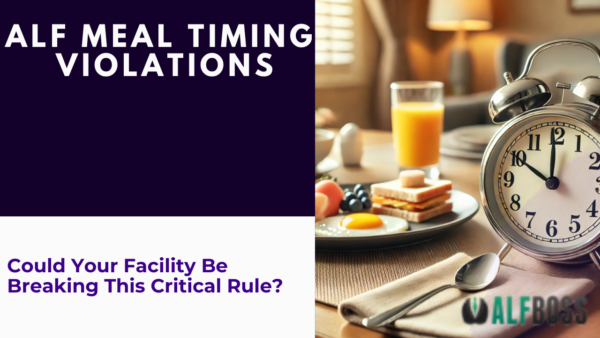ALF Meal Timing Violations: Could Your Facility Be Breaking This Critical Rule?
When it comes to meal scheduling in assisted living facilities, timing isn’t just a matter of convenience—it’s a state-regulated requirement that can impact compliance, resident well-being, and even your facility’s reputation. Florida’s 59A-36.012 Food Service Standards lay out clear rules for meal timing, but many facilities unknowingly violate them, putting their compliance at risk.
Could your facility be one of them? Let’s break down what the regulation says, why it matters, and how to ensure you’re meeting the standard.
What Does the Regulation Say?
According to Florida Administrative Code 59A-36.012(2)(f):
- No more than 14 hours can pass between the end of an evening meal (dinner) and the beginning of the next morning meal (breakfast).
- Intervals between meals must be evenly distributed throughout the day.
- The time between the end of one meal and the start of the next must be no less than 2 hours and no more than 6 hours.
- If residents do not have access to a kitchen, the facility must offer snacks at least once per day—but snacks do not count as meals when calculating meal intervals.
These rules exist to ensure residents receive adequate nutrition at consistent intervals, preventing long periods without food that could lead to health risks such as low blood sugar, fatigue, and poor appetite regulation.
Examples of Meal Schedules That Meet the Requirement
To stay compliant, your facility’s meal schedule needs to be planned carefully. Below are some examples of compliant meal schedules:
 Compliant Schedule #1 (Standard Spacing)
Compliant Schedule #1 (Standard Spacing)
![]() Breakfast: 7:30 AM
Breakfast: 7:30 AM
![]() Lunch: 12:30 PM (5 hours after breakfast)
Lunch: 12:30 PM (5 hours after breakfast)
![]() Dinner: 6:30 PM (6 hours after lunch)
Dinner: 6:30 PM (6 hours after lunch)
![]() Next Day Breakfast: 7:00 AM (12.5 hours after dinner)
Next Day Breakfast: 7:00 AM (12.5 hours after dinner)
Why it works: No more than 14 hours pass between dinner and breakfast, and all meals are spaced within 2 to 6 hours.
 Compliant Schedule #2 (Earlier Breakfast and Lunch)
Compliant Schedule #2 (Earlier Breakfast and Lunch)
![]() Breakfast: 7:00 AM
Breakfast: 7:00 AM
![]() Lunch: 11:30 AM (4.5 hours after breakfast)
Lunch: 11:30 AM (4.5 hours after breakfast)
![]() Dinner: 5:30 PM (6 hours after lunch)
Dinner: 5:30 PM (6 hours after lunch)
![]() Next Day Breakfast: 6:30 AM (13 hours after dinner)
Next Day Breakfast: 6:30 AM (13 hours after dinner)
Why it works: Again, meal spacing is evenly distributed and remains within compliance.
What Does a Non-Compliant Schedule Look Like?
Many facilities unknowingly fall into non-compliance by allowing too much time between meals or failing to adhere to the 14-hour overnight limit.
 Non-Compliant Schedule (Exceeds Time Limits)
Non-Compliant Schedule (Exceeds Time Limits)
![]() Breakfast: 7:30 AM
Breakfast: 7:30 AM
![]() Lunch: 1:30 PM (6 hours after breakfast—maximum limit reached!)
Lunch: 1:30 PM (6 hours after breakfast—maximum limit reached!)
![]() Dinner: 7:45 PM (6 hours 15 minutes after lunch—exceeds the limit!)
Dinner: 7:45 PM (6 hours 15 minutes after lunch—exceeds the limit!)
![]() Next Day Breakfast: 9:00 AM (13 hours 15 minutes after dinner—risking the overnight limit!)
Next Day Breakfast: 9:00 AM (13 hours 15 minutes after dinner—risking the overnight limit!)
Why this fails:
![]() Lunch and dinner exceed the 6-hour maximum interval
Lunch and dinner exceed the 6-hour maximum interval
![]() Evening to morning meal interval is close to the 14-hour limit, leaving no room for flexibility
Evening to morning meal interval is close to the 14-hour limit, leaving no room for flexibility
Even a small delay in meal service could push this schedule into a clear compliance violation.
What Happens If You Don’t Follow the Regulation?
Failing to adhere to these meal timing rules can lead to:
![]() Compliance violations – State inspections could cite your facility, leading to penalties or corrective action.
Compliance violations – State inspections could cite your facility, leading to penalties or corrective action.
![]() Resident health risks – Long gaps between meals can cause fatigue, malnutrition, low blood sugar, and increased fall risk—especially in elderly residents.
Resident health risks – Long gaps between meals can cause fatigue, malnutrition, low blood sugar, and increased fall risk—especially in elderly residents.
![]() Poor resident satisfaction – Residents may become irritable, anxious, or complain about meal timing, impacting the facility’s reputation.
Poor resident satisfaction – Residents may become irritable, anxious, or complain about meal timing, impacting the facility’s reputation.
Keeping meal intervals within the required timeframe isn’t just about avoiding citations—it’s about ensuring residents receive proper nutrition at the right times.
How to Stay in Compliance
To ensure your facility meets Florida’s meal timing regulations:
![]() Set a standard meal schedule and communicate it to all kitchen staff.
Set a standard meal schedule and communicate it to all kitchen staff.
![]() Monitor meal service times daily to ensure timely delivery.
Monitor meal service times daily to ensure timely delivery.
![]() Use a meal tracking system to document meal times for compliance records.
Use a meal tracking system to document meal times for compliance records.
![]() Plan for delays by having snacks available if mealtime is unexpectedly pushed back.
Plan for delays by having snacks available if mealtime is unexpectedly pushed back.
![]() Educate staff on the importance of meal timing and compliance requirements.
Educate staff on the importance of meal timing and compliance requirements.
By proactively managing meal schedules, you can ensure compliance, keep residents satisfied, and maintain the highest level of care.
Final Thought: Is Your Facility Following the Rule?
Many facilities assume they’re in compliance—until an inspection proves otherwise. Take a moment to review your meal schedule and make sure you’re following the 59A-36.012 Food Service Standards correctly.
If you have any questions about compliance, scheduling, or best practices, feel free to reach out—I’m here to help!
